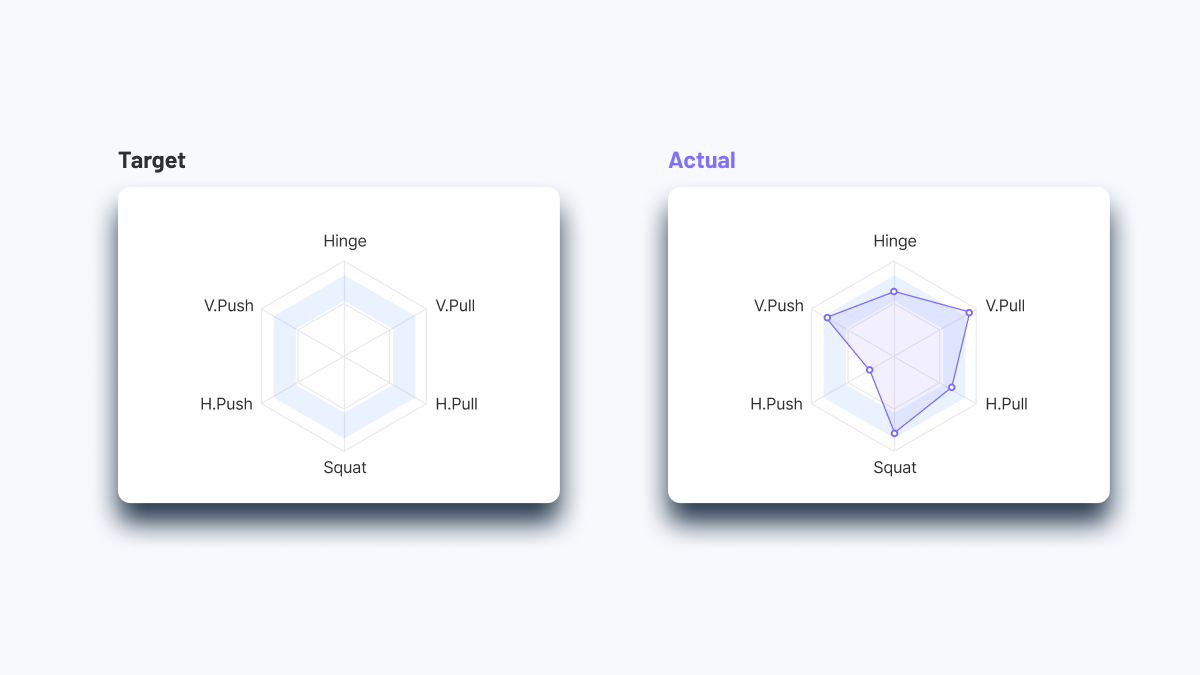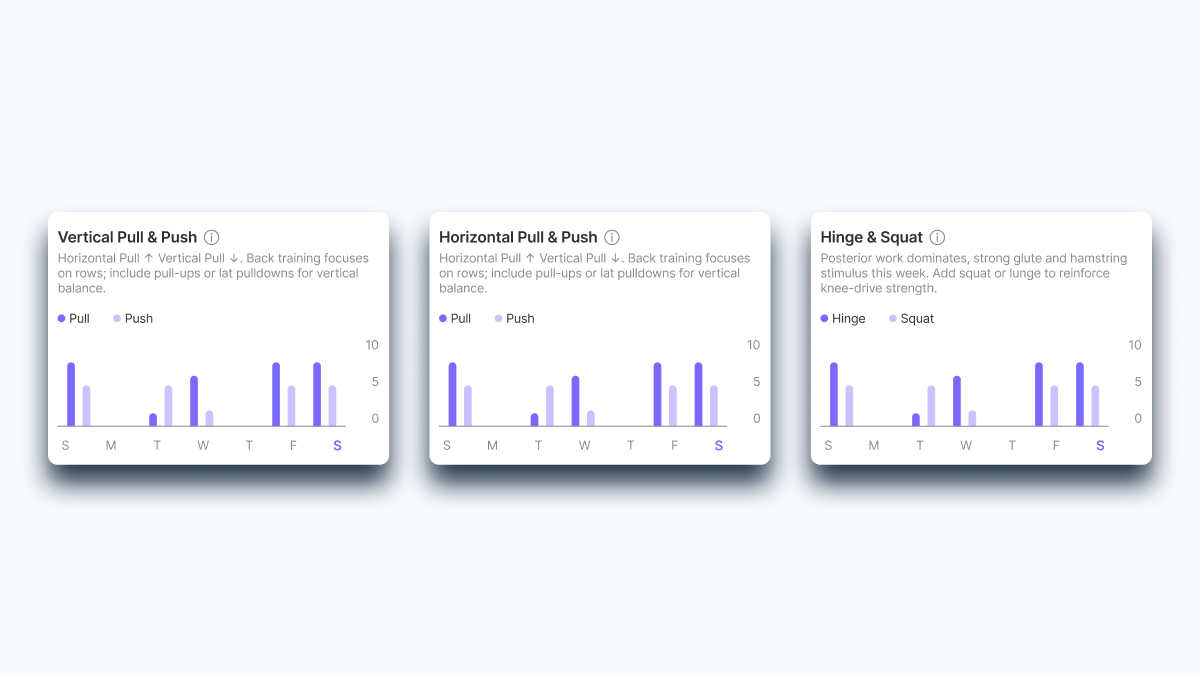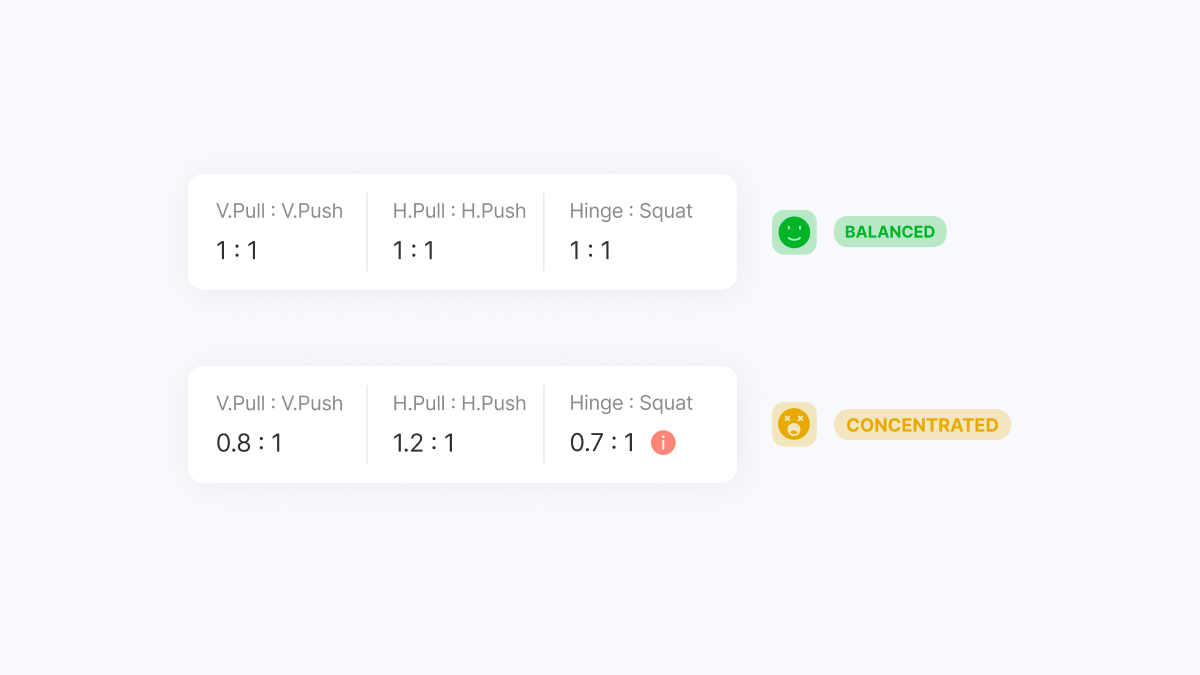Why True Progress Requires Balanced Pattern
Strength and volume show how much you’re progressing — but balance shows how well.
The Movement Balance Engine is the third pillar of Jefit’s Progressive Overload (PO) System and one of the key components behind your NSPI dashboard.
It helps you see how evenly your training stimulates all major movement patterns — ensuring your progress stays stable, strong, and injury-resilient over time.
Table of contents
What Movement Balance Measures
How the Movement Balance Graph Works
How to Read It
Why Balance Matters in the PO System
How the Balance Engine Works Behind the Scenes
Personalized by Goal and Experience
How to Use It
Why It Completes the NSPI
What’s Next
Explore More
North Star Progress Index Overview →
Strength Engine →
Stimulus Engine →
In Short
What Movement Balance Measures
Every exercise you log belongs to one or more movement patterns, the biomechanical foundations of human strength:

- Vertical Push (e.g., Shoulder Press)
- Vertical Pull (e.g., Pull-Up, Lat Pulldown)
- Horizontal Push (e.g., Bench Press, Push-Up)
- Horizontal Pull (e.g., Row Variations)
- Hinge (e.g., Deadlift, Hip Thrust)
- Squat (e.g., Back Squat, Leg Press)
Jefit tracks how many effective sets (Hard-Set Equivalents) you perform for each pattern across the week and compares them to your goal-based targets.
The result is your Movement Balance score — a reflection of how symmetrical your weekly training stress is across these fundamental patterns.
How the Movement Balance Graph Works
Your dashboard shows a hex-shaped radar chart, where each corner represents one of the six key patterns.

- The outer line shows your weekly target set count for each pattern.
- The inner line shows your actual accumulated sets (HSE).
A balanced shape means your training load is evenly distributed.
If one side of the hexagon collapses inward — for example, vertical push or squat lagging — that’s your cue to rebalance upcoming sessions.
Below the radar chart, you’ll also see three paired pattern groups with real-time ratios:

- Vertical Pull : Vertical Push
- Horizontal Pull : Horizontal Push
- Hinge : Squat
Each ratio indicates the relationship between opposing patterns.
The closer these are to 1 : 1, the better your mechanical balance and long-term joint health.
How to Read It

- Balanced Ratios (≈ 1 : 1) → Excellent equilibrium. Your pressing and pulling volumes match, supporting joint stability and power transfer.
- Mild Skew (e.g., 1.5 : 1) → Acceptable short-term emphasis, often used for goal-specific focus blocks.
- Severe Skew (e.g., 3 : 1 or higher) → Indicates pattern imbalance — overuse of one direction or plane. Add complementary work to restore symmetry.
💡 Tip: Balance doesn’t mean doing equal reps of everything every week — it means your total effective work stays proportionate over time.
Why Balance Matters in the PO System
The PO System isn’t just about lifting more or doing more — it’s about training smarter.
Movement Balance ensures that your Strength and Stimulus Volume gains are supported by a well-structured foundation.
Here’s why it’s critical:
- Joint Health & Longevity – Balanced push/pull and hinge/squat ratios reduce chronic joint stress and prevent overuse injuries.
- Performance Efficiency – Balanced movement patterns improve force transfer and coordination, helping you lift more efficiently.
- Aesthetic Symmetry – Training balanced patterns leads to proportional muscle development and better overall physique.
- Recovery & Adaptation – Uneven workloads create local fatigue; balanced workloads distribute stress evenly and improve recovery quality.
By integrating pattern balance directly into your NSPI, Jefit ensures that every gain you make in strength or volume is sustainable — not short-lived.
How the Balance Engine Works Behind the Scenes
The system continuously evaluates your logged sets through three steps:
- Pattern Tagging – Each exercise carries predefined pattern tags from Jefit’s movement library.
- Set Aggregation – Weekly HSE totals are computed for each pattern (weighted by EMG and exercise role).
- Ratio Analysis – The engine calculates vertical, horizontal, and lower-body ratios, flagging deviations beyond your goal-based tolerance range.
Your balance feedback message summarizes this instantly — for example:
“Vertical Pull dominant — add vertical pressing next week for better upper-body alignment.”
These insights help you adjust before imbalance becomes a problem.
Personalized by Goal and Experience
Your ideal balance ratios vary depending on your goal and training level:
- Strength & Power Goals: Slight pull dominance to reinforce posterior-chain control.
- Hypertrophy Goals: Near-perfect 1 : 1 ratios to maximize proportional development.
- Cutting or Maintenance: Slight push or squat bias to maintain major movers while lowering fatigue.
As you log workouts, the PO System adapts your balance targets automatically — your ratios evolve as your plan evolves.
How to Use It
- Check the radar chart: Aim for a well-rounded hex shape by the end of the week.
- Review the ratios: Stay near 1 : 1 unless you’re in a targeted emphasis phase.
- Adjust upcoming sessions: Add missing pattern work or recovery sessions based on what’s lagging.
Consistency here feeds directly into your NSPI Movement Balance trend — a key contributor to your overall progress index.
Why It Completes the NSPI
Strength shows improvement.
Stimulus Volume shows workload.
Movement Balance ensures it’s all built on stability.
Together, these three form the feedback loop that powers your NSPI — helping you build not just strength, but resilient, well-rounded performance.
What’s Next
In future releases, Movement Balance data will integrate directly into plan-level recommendations, automatically adjusting your exercise mix when pattern ratios drift too far from ideal.
Jefit’s goal is to help you progress faster — and stay injury-free while doing it.
Explore More
Explore the rest of the NSPI System:
In Short
The Movement Balance Engine ensures your training stays structurally sound by tracking the relationship between key movement patterns.
Balanced ratios mean you’re building strength and volume on a solid foundation — the hallmark of intelligent, long-term progress.
Because real progress isn’t just stronger — it’s stronger and balanced.
- The Science Behind Jefit’s Load Progression Engine - November 20, 2025
- The Stimulus Volume Engine - November 19, 2025
- The Movement Balance Engine - November 19, 2025